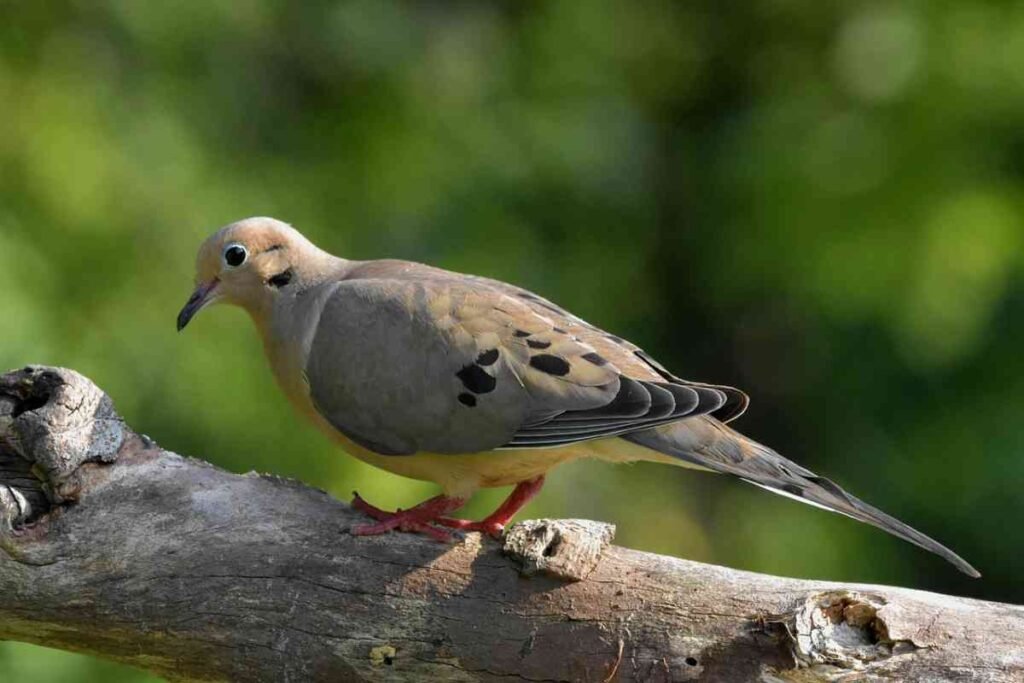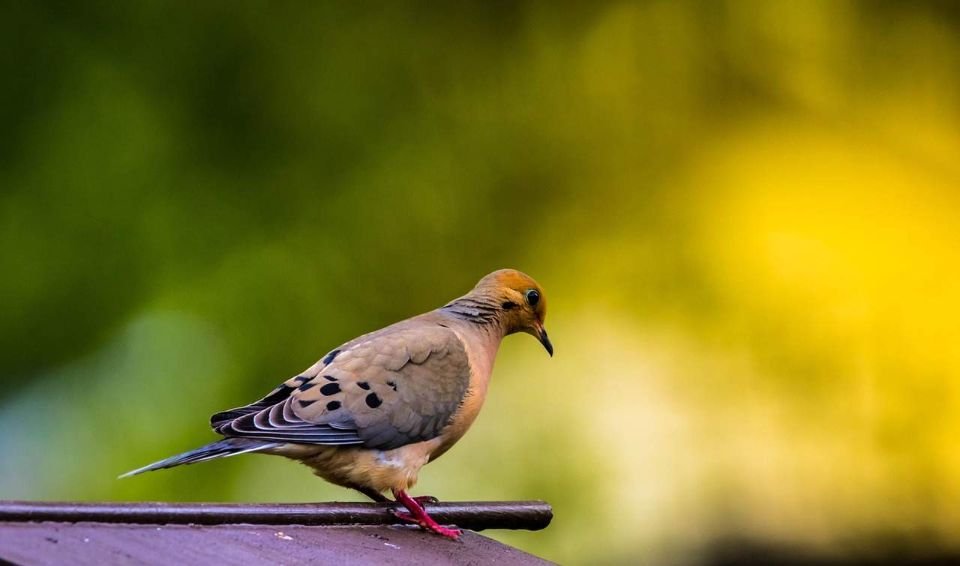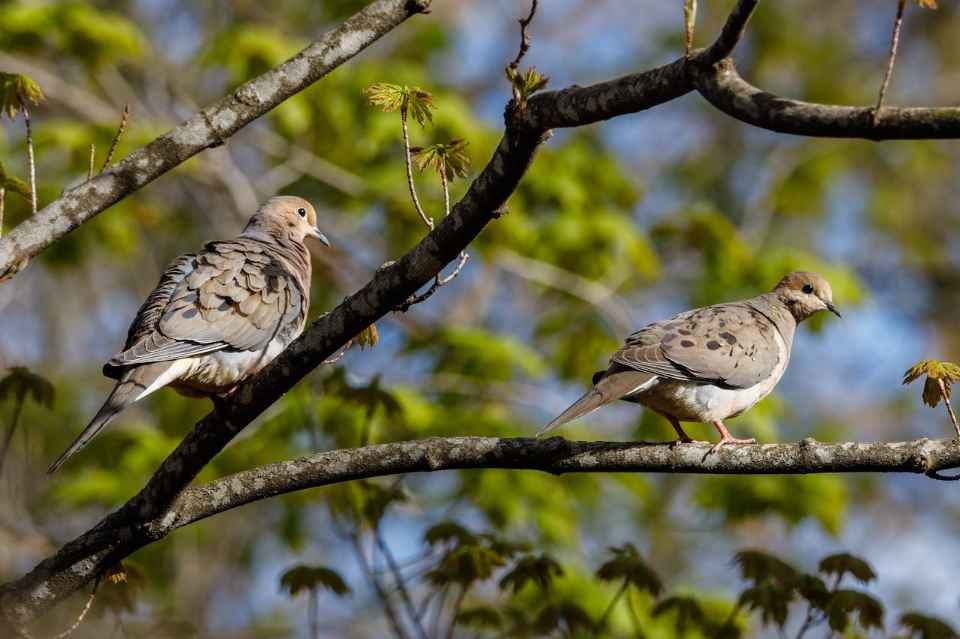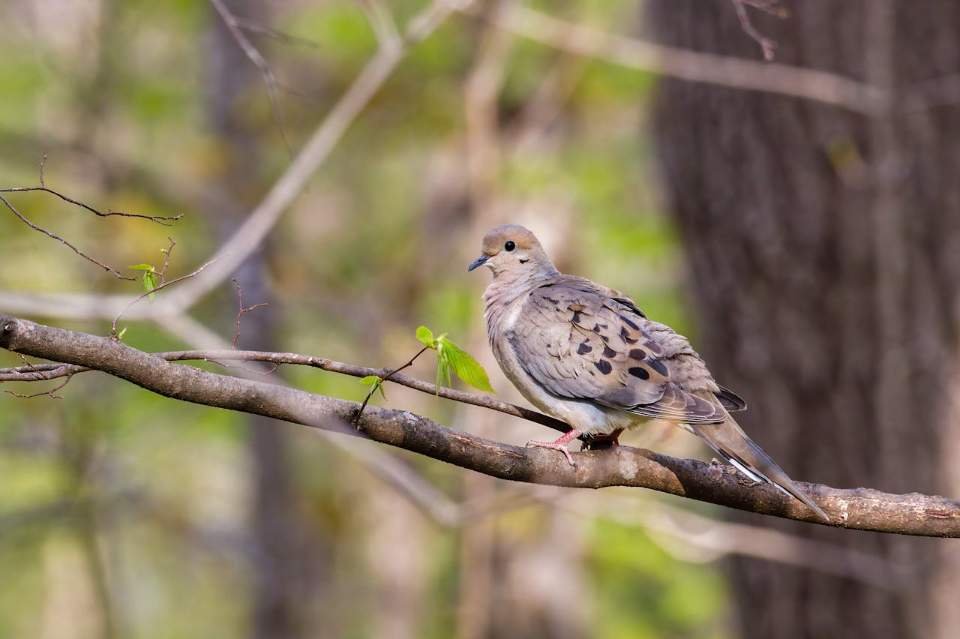Ever sit on your porch with your morning coffee ☕ and hear that soft, haunting “coo-oo-oo” floating through the air? Yeah, that’s our friend the mourning dove doing their thing. I used to think they were just randomly making noise until I started paying attention to when and why they actually coo.
Turns out, these birds have more to say than you’d think! Let me walk you through everything I’ve learned about mourning dove communication. Trust me, once you understand what’s going on, you’ll never hear that cooing the same way again.
📌 Quick Answer: Why Do Mourning Doves Coo?
- Territory: Males coo to claim space and warn off rivals.
- Mating: Their cooing attracts potential mates during breeding season.
- Pair Bonding: Paired doves use softer coos to coordinate nesting and strengthen their bond.
- Timing: Most cooing happens in spring and early mornings when sound carries best.
What Exactly IS Cooing?
Before we jump into the why, let’s talk about what cooing actually is. Mourning dove cooing is basically their version of texting, calling, and posting on social media all rolled into one vocal package.
The sound comes from their syrinx (that’s bird-speak for voice box), and it’s surprisingly complex (according to Congress.of.the.Birds). When you hear that gentle “oo-wah-hoo-hoo-hoo,” you’re listening to a carefully crafted message that other mourning doves understand perfectly.
Fun fact: Male mourning doves are the primary cooers. The ladies? They’re usually too busy rolling their eyes at the males’ dramatic performances 🙂
The Science Behind the Sound
Mourning doves create their signature coo through a combination of airflow manipulation and specialized muscle contractions. Their syrinx sits right where their trachea splits into two bronchi, giving them incredible control over pitch and volume (study).
Curious what all this cooing sounds like? Listen to mourning dove sounds here and hear the magic for yourself.
What makes their cooing so distinctive is the low frequency. These sounds travel really well through forests and neighborhoods alike—nature basically gave them the perfect communication system for their lifestyle.
The Main Reasons Mourning Doves Coo
Now here’s where it gets interesting. Mourning doves aren’t just making pretty sounds for our entertainment (shocking, I know). They’ve got specific reasons for all that cooing.
Territory Claims and Boundary Setting
Picture this: You’re a male mourning dove who just found the perfect spot to build a nest. Nice tree, good view, close to food sources. But how do you make sure every other dove in the neighborhood knows this prime real estate is taken?
You coo. Loud and proud.
Male mourning doves use their cooing as a “No Trespassing” sign. That persistent morning cooing you hear? That’s a dove essentially saying, “This is MY tree, MY yard, MY territory. Move along, buddy’ (according to Illinois DNR).
I’ve watched this territorial cooing in action in my own backyard. One male dove claimed the oak tree by my kitchen window, and for weeks, he’d start cooing at dawn like clockwork. Any other dove that dared land nearby got the full vocal treatment until they flew off.
Attracting Mates (AKA Dove Dating)
Here’s where mourning doves get romantic. During breeding season, male cooing becomes less about territory and more about advertising their availability to potential mates.
Think of it as their personal dating profile, but in audio form:
- Consistent cooing = “I’m healthy and strong”
- Extended cooing sessions = “I’ve got stamina”
- Strategic positioning while cooing = “Look at this amazing territory I can provide”
Female mourning doves actually evaluate potential partners based on their cooing performance. The males with the most consistent, robust cooing tend to attract mates faster. It’s like a vocal fitness test.
Communication Between Established Pairs
Once mourning doves pair up (and they mate for life, by the way), their cooing takes on a whole different meaning. Bonded pairs use softer cooing patterns to:
- Coordinate daily activities
- Signal when they’re ready to switch nest-sitting duties
- Maintain their emotional connection
I’ve observed a pair that nested in my neighbor’s pine tree for three consecutive years. Their quiet back-and-forth cooing during nest changes was almost conversational. Way more civilized than most human relationships, IMO.
Seasonal Patterns in Mourning Dove Cooing
Ever notice how mourning dove cooing seems more intense at certain times of year? You’re not imagining things.
Spring: The Cooing Olympics
Spring is when mourning doves really turn up the volume. March through June represents peak cooing season because:
- Territorial disputes are at their highest
- Mate selection is in full swing
- Nesting preparations require constant communication
During peak spring cooing, you might hear doves from dawn until dusk. It’s like living in the middle of a very polite bird argument. (According to Naturally Curious with Mary Holland, this seasonal increase is typical for mourning doves.) If you’re interested in getting outside to enjoy this activity, check out our guide to spring birdwatching tips for beginners.
Summer: Family Mode
Once eggs are laid and babies arrive, cooing patterns shift dramatically. Parent doves use quieter, more subtle vocalizations to avoid attracting predators to their nest.
Summer cooing focuses on:
- Coordinating parental duties
- Teaching young doves proper vocalization
- Maintaining pair bonds
Fall and Winter: The Quiet Months
Mourning doves significantly reduce their cooing during colder months. With breeding season over and food becoming the primary focus, they save their energy for survival rather than communication.
You’ll still hear occasional cooing during winter, but it’s usually related to flock coordination rather than territorial or mating behaviors.
Different Types of Mourning Dove Calls
Not all mourning dove sounds are created equal. These birds actually have a surprisingly diverse vocabulary:
The Classic Advertising Coo
This is the sound most people associate with mourning doves: “oo-wah-hoo-hoo-hoo.” It’s primarily used by males for territorial and mating purposes.
The Nest Call
Softer and shorter than the advertising coo, nest calls help coordinate activities between mated pairs. It sounds more like “coo-coo” without the extended trailing notes.
Alarm Calls
When threatened, mourning doves produce sharp, rapid “cook-cook-cook” sounds. It’s completely different from their usual gentle cooing and serves as a warning to other doves.
Wing Whistles
Okay, this technically isn’t cooing, but it’s worth mentioning. When mourning doves take off quickly, their wings create a distinctive whistling sound. It’s another form of communication that warns other birds of potential danger.
Environmental Factors That Influence Cooing
Mourning doves are surprisingly smart about when and where they vocalize. Several environmental factors affect their cooing patterns (ScienceDirect).
Weather Conditions
- Clear mornings = prime cooing time
- Windy days = reduced cooing (sound doesn’t carry as well)
- Before storms = increased cooing activity
Urban vs. Rural Settings
City doves have actually adapted their cooing to compete with traffic noise. Urban mourning doves coo louder and at different frequencies compared to their rural cousins. Evolution in action, right there.
Time of Day
Most intense cooing happens during the first few hours after sunrise. This timing maximizes sound travel when air is still and other bird species are less active.
What Mourning Dove Cooing Tells Us About Bird Intelligence
Here’s something that might surprise you: mourning dove cooing patterns suggest these birds are way smarter than we give them credit for.
Social Learning
Young mourning doves learn cooing patterns from their parents and other adults. They don’t just instinctively know how to coo effectively – it’s a learned skill that improves with practice.
Environmental Adaptation
Mourning doves adjust their cooing based on their surroundings. Forest doves coo differently than suburban doves, and coastal populations have distinct vocal patterns compared to inland birds.
Individual Recognition
Research suggests mourning doves can recognize individual voices within their cooing. Pairs can identify their mates’ calls even in a crowd of other cooing doves.
Common Misconceptions About Mourning Dove Cooing
Let me clear up some myths I’ve heard over the years:
“They Only Coo When Sad”
The name “mourning” dove comes from their melancholy-sounding call, not because they’re actually mourning anything. These birds coo when they’re perfectly happy and healthy (Audubon).
“All Doves Coo the Same”
Each mourning dove has a slightly unique vocal signature. Once you start paying attention, you can actually distinguish between individual birds in your area.
“Cooing is Just Random Noise”
Every cooing session has purpose. Whether it’s territorial, romantic, or social, mourning doves don’t waste energy on meaningless vocalizations.
How to Encourage Mourning Doves in Your Yard
Want more of that peaceful cooing around your home? Here’s what works:
- Provide water sources (birdbaths, shallow dishes)
- Offer appropriate food (millet, cracked corn, sunflower seeds)
- Create nesting opportunities (dense shrubs, platform feeders)
- Minimize disturbances during breeding season
FYI, mourning doves prefer ground feeding, so scatter seeds on clean surfaces rather than using hanging feeders exclusively.
The Bigger Picture: Cooing and Ecosystem Health
Mourning dove cooing patterns can actually indicate environmental health. Consistent, robust cooing suggests:
- Adequate food sources
- Low predator pressure
- Minimal habitat disruption
- Healthy breeding populations
When cooing patterns change dramatically in an area, it often signals ecosystem changes worth investigating.
Personal Observations and Final Thoughts
After years of listening to the mourning doves around my home, I’ve come to appreciate just how complex their communication really is. What started as background noise has become a fascinating window into bird behavior and intelligence.
Last spring, I watched a pair build their nest in my maple tree and raise three broods throughout the season. Their cooing patterns changed with each stage – from initial courtship calls to quiet parental communications to teaching their young proper vocalizations.
That experience completely changed how I hear mourning dove cooing. It’s not just pretty background music anymore; it’s a sophisticated communication system that connects these birds to their environment and each other in ways we’re just beginning to understand.
Next time you hear that familiar “coo-oo-oo” drifting through your neighborhood, take a moment to really listen. You might discover there’s a lot more conversation happening than you ever realized. And honestly? That’s pretty amazing when you think about it.
FAQ About Mourning Dove Cooing
Why Do Mourning Doves Coo So Much?
Mourning doves repeat their cooing to reinforce territory claims and attract mates during breeding season. The more often a male coos, the more he signals strength and persistence to both rivals and potential partners.
Why Do Mourning Doves Coo in the Morning?
Morning air is cool and calm, which helps sound travel farther. Doves coo at sunrise to maximize the reach of their calls when competitors and mates are most active.
Do Female Mourning Doves Coo Too?
Females rarely coo compared to males. Most cooing comes from males as part of territorial and mating behavior, while females use softer calls mainly for communication with their mates or young.
Is Cooing the Same as Mourning Dove Mating Calls?
Yes and no. The classic long cooing sequence serves both as a territorial claim and a mating call. However, paired doves also use shorter, gentler coos to coordinate nest duties and maintain their bond, which are not meant to attract new mates.
Conclusion
Mourning dove cooing serves multiple critical functions: establishing territory, attracting mates, coordinating family activities, and maintaining social bonds. These gentle sounds represent a sophisticated communication system that’s helped mourning doves thrive across North America.
Understanding why mourning doves coo gives us insight into their behavior, intelligence, and ecological needs. It also helps us appreciate the complex natural world that exists right in our own backyards.
So tomorrow morning when you hear that first soft coo floating through the air, you’ll know you’re not just listening to a bird making noise. You’re eavesdropping on conversations, territorial negotiations, and love songs that have been perfecting themselves for thousands of years.
Pretty cool way to start the day, don’t you think? 🙂





